
Population of Dagestan
Russia Federation

According to the 1989 census in Dagestan recorded representatives of 102 nationalities. Thus, among the so-called Indigenous peoples are belonging to three linguistic families:
1. To Nakh-Dagestani branch of the Ibero-Caucasian language family are Avars (along with 14 ethnic groups having distinct but close Avar, languages, namely ahvahtsami, karatintsami, Andis, botlihtsami, godoberintsami, Tyndall chamalyaltsami, bagulalami, hvarshinami, didoytsami, Bezhtins, gunzibtsami, ginuhtsami and archintsami) Dargin (including Kubachins and kaytagtsev) Lezghins, Laks, Tabasarans, Rutuls, Aguls, Tsakhurs and Chechens.

Dargin - the second largest ethnic group in Dagestan - make up 16.1% of the population (332.4 thousand people). Territory traditionally inhabited Dargin - mountain and foothill regions of Dagestan average. About 68% Darginians resettled in 16 rural areas. In Akushinsky, Dahadaevskom, Karabudkhentskie, Levashinskom and Sergokalinsky Dargins areas ranging from 75 to 100 people. Significant share of their Kayakentsky and Karabudakhkent areas (respectively 43 and 36%). They also live in Tarumovsky (19%), Kizlyar (15%) and Buynaksk (14%) regions. In Derbent, Nogai, Agul, Babayurtovskiy, Hasavjurtovskom and share Darginians Kumtorkalinsky areas varies from 4 to 9% of the population in these areas. Dargin - the townspeople live in Izberbash (57% of the population of the city), Makhachkala (12.4%), Kizlyar (7.3%), Buynaksk (6.6%), Khasavyurt (4.2%) and Daghestan Lights (9%). Famous Dargin village Kubachi refers to the townships. Dargin also many villages in Achisu, Manaskent and Mamedkala.

Avars - the most numerous ethnic group in Dagestan. Currently, their republic 577.1 thousand people, representing 27.9% of the population. The main area of settlement - the western regions of mountainous Dagestan. The rural population is 68% of the Avars and settled mainly in the 22 districts of the republic. In Akhvakh, Botlikh, Gergebilskaya, Gumbetovsky, Gunibsky, Kazbek, Tlyaratinskiy, Untsukulsky, Khunzakh, Tsumandinskiy, Tsuntin, Charodinskom and Shamil areas Avars up 98-100 percent of the population. In Kizilyurt district Avars share rose to nearly 80% in the Khasavyurt, Kizlyar, Buynaksk Kumturkalinskom and they make up a third, and in Tarumovsky, Babayurtovskiy, Levashinskom and Novolakskoe - up to a quarter of the total population. In cities and towns live 32% of the Avar population. In Makhachkala, they make up 21% in Kizilurt, South Suhokumsk and Buynaksk - 43-52%, in Khasavyurt, Kizlyar and Caspian - 12-22% Avars constitute a significant part of the population townships: Bavtugay New Sulak, Shamilkala, Oaks, Shamhal .

Kumyks account for 267.5 thousand persons and constitute 12.9% of the population. The grounds of their traditional settlement - Terek-Sulak lowland and foothill areas of Dagestan. More than half Kumyks (52%) live in rural areas 8. In the area of their Kumtorkalinsky 67.5% in Karabudakhkent - 62% Buinaksk - 55% Kayakentsky - 51% Babayurtovskiy - 44% Hasavjurtovskom - 28.5% Kizilyurt - 13.6%, in Karabudkhentskie - 9% of the population areas. In Makhachkala, they constitute 15% of the population in Buynaksk - third Khasavyurt - quarter and Kizilurt - fifth of the population. In Izberbash - 17% and the Caspian - 10% in Derbent Kumyks less than one percent. Some part Kumyks resettled in towns: in Tarka - 91% of the population, Tube - 36% Leninkent - 31.3% Kyakhulay - 28.6%, Alburikente - 27.6%, Shamkhalov - 26.8%, Manaskente - 24.9%

Lezghins in Dagestan is currently 250.7 thousand people, representing 12.2 % of the population . The main settlement area Lezghins - upland , lowland and foothill Southern Dagestan . Rural population ( about 64 %) are settled in 9 areas. In Ahtynskogo , Dokuzparinsky , Kurakh , Magaramkentski and Suleiman Stalsky areas, they range from 93 to 100% , in Hivskom - 37.3 and Rutul - 8 % of the population . Part Lezghins living in Derbent ( 15%) and Hasavjurtovskom (6 %) regions . Lezghins - the townspeople are mainly concentrated in Derbent (26%) , Dagestan Lights ( 22%), the Caspian Sea ( 16%), Makhachkala (9.5 %) and Izberbash ( 8%). They constitute the main population of the village Belidzhi and about 10% of the village Mamedkala .

Russian is considered one of the peoples of Dagestan . Now they are in the country 150.1 thousand people (7.3 % of the population ) . Over 80% of Russian Dagestan settled in all cities and towns , but only in Kizlyar , they make up more than half the population ( 54%). Quite significant proportion in Makhachkala and the Caspian Sea ( 17-18% ) , in other cities , their share varies from 3 to 10 % of the population . Russian constitute the main population townships Komsomol (81% ), relatively numerous in Dubki ( 16%) and Sulak ( 12%). Russian rural population ( Terek Cossacks ) is concentrated in the lower reaches of the Terek and its ducts in the territory of Kizlyar and Tarumovsky areas where their numbers , both relative and absolute , in recent years significantly reduced ( 27.2 and 30.4 %, respectively) . A small number of Russian rural living also Babayurtovskiy (1.5 %) , Hasavjurtovskom (0.4%) , Nogaysky (1.8 %) , and Derbent (0.7 %) regions .
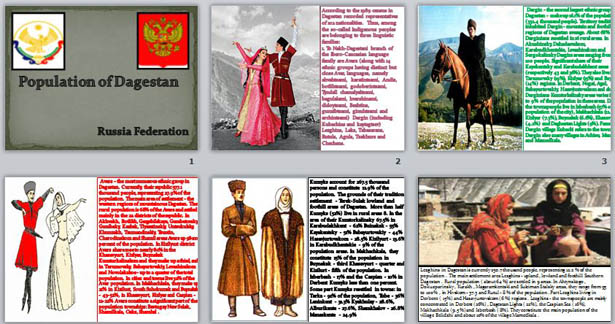

 Получите свидетельство
Получите свидетельство Вход
Вход











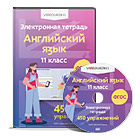
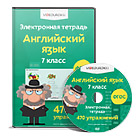
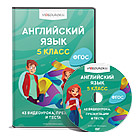

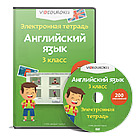

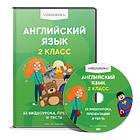
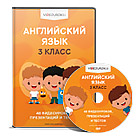
 Презентация по английскому языку "Моя многонациональная малая Родина-Дагестан" (1.21 MB)
Презентация по английскому языку "Моя многонациональная малая Родина-Дагестан" (1.21 MB)
 0
0 667
667 10
10 Нравится
0
Нравится
0


